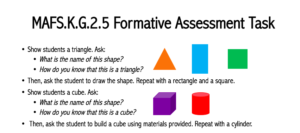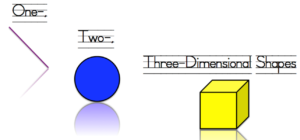MAFS.K.G.2.5: Model shapes in the world by building shapes from components (e.g., sticks and clay balls) and drawing shapes.
Cognitive Complexity Level: 1-Recall
[divider] [/divider] Students are able to…
- Build three-dimensional solid shapes (cubes, cones, spheres, and similar shapes) with different tools (e.g. straws, pipe cleaners, gum drops, clay, marshmallows, and toothpicks)
- Draw two-dimensional shapes (triangles, rectangles, squares, circles) on dot or grid paper.
[divider] [/divider] Students are able to…because teachers:
- Assist students with identifying similarities and differences of two-dimensional and three-dimensional shapes.
- Use cutouts and stencils to support students who may initially struggle with drawing shapes.
- Promote connections between models and drawings.
[divider] [/divider] Questions to ask students:
- What shapes did you make? How did you make them?
- Turn your shapes. Are they still the same shape?
- Can you draw a shape with four sides? What is the name of that shape?
[divider] [/divider] Additional Resources:
Additional in depth content knowledge
LearnZillion Video: Build shapes with clay and straws
[divider] [/divider] Sample Formative Assessment Tasks:

[divider] [/divider] Resources/Tasks to Support Your Child at Home:
- Assist your child in identifying shapes in your home. For example, these objects can be simple and commonly found in the home such as the face of a wall clock (circle) and picture frame (rectangle). Ask your child to choose 3-4 shapes and draw them for you.
- LearnZillion Video: Build a shape playground
